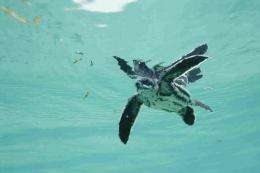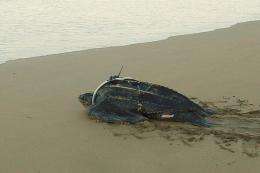Sea turtles surf an ocean highway to safer habitat, Stanford research suggests

(PhysOrg.com) -- The first few days of life for a leatherback turtle are no easy walk on the beach.
As hatchlings attempt to make their way from their nesting site on the sand to the ocean, where they will find food and eventually meet a mate, they face predators at every turn.
The ocean isn't much kinder than the beach, as fish attack the baby turtles, and pollution and fishing nets threaten their survival as they grow.
But a new study suggests that where the turtles are born may be as important for their chances of survival as how good they are at dodging life's obstacles.
The study, conducted by marine biologist George Shillinger at the Stanford-affiliated Center for Ocean Solutions in Monterey, Calif., and a team of colleagues, indicates that strong currents off the coast of Costa Rica may help whisk the baby turtles to safer habitats.
"The turtles are on edge. They're being slammed at every turn," Shillinger said. "It's useful to find out what happens to the turtles when they leave the beach and if there are factors that help them survive."

Shillinger said the study showed a so-called "hatchling highway" off Playa Grande beach in Costa Rica, where winds create large eddies that provide shelter and nutrients for the turtles. The highway appears to transport the turtles into warm offshore waters where they can grow quickly.
"The study shows that there are areas in this world that are special for the leatherback and if you destroy the nesting beach, you take away from the turtles a very important launch pad," he said.
Very few turtles – only about 1 in 1,000 – return to the beach where they were born, about 10 years after they leave. The time between their departure and return is not well understood by scientists. Baby leatherbacks are hard to track because of their size – about equal to a computer mouse.
Shillinger's study seeks to shed light on that period, which scientists have dubbed the "lost years."
"To effectively manage an animal that is highly migratory you need to look at where it lives during different phases of its life," said Shillinger, who is now the executive director of another Stanford-affiliated organization, the Tag-a-Giant Foundation. "If you just focus on protecting adults, you may miss a chance to improve the situation earlier on."
Because the baby turtles are so small, Shillinger and his team used computer models to simulate the path of the turtles rather than deploying satellite tags or radio transmitters.
The researchers entered into the simulation physical oceanographic characteristics such as water temperature, sea surface height, winds and currents across the eastern Pacific region, spanning from Mexico to Panama, where leatherbacks are known to nest.
They used this data to simulate hatchling dispersal from four different leatherback nesting beaches during the peak hatchling emergence periods (January through April) between 2000 and 2008. The study was reported online Wednesday in the Proceedings of the Royal Society B, a British scientific journal.
Shillinger said now that researchers have an idea of where the baby turtles disperse, they can seek them out through surveys and potentially through tracking studies to test their hypotheses in the real world rather than just through a computer model.
"Once we put all of this together we might start to really understand the life history of these turtles from emergence to adulthood," Shillinger said. "And that information helps us develop conservation strategies that link leatherback nesting beaches, hatchling highways and nursery habitats with migration corridors and foraging hotspots for juvenile and adult turtles across the Pacific."
Journal information: Proceedings of the Royal Society B
Provided by Stanford University

















